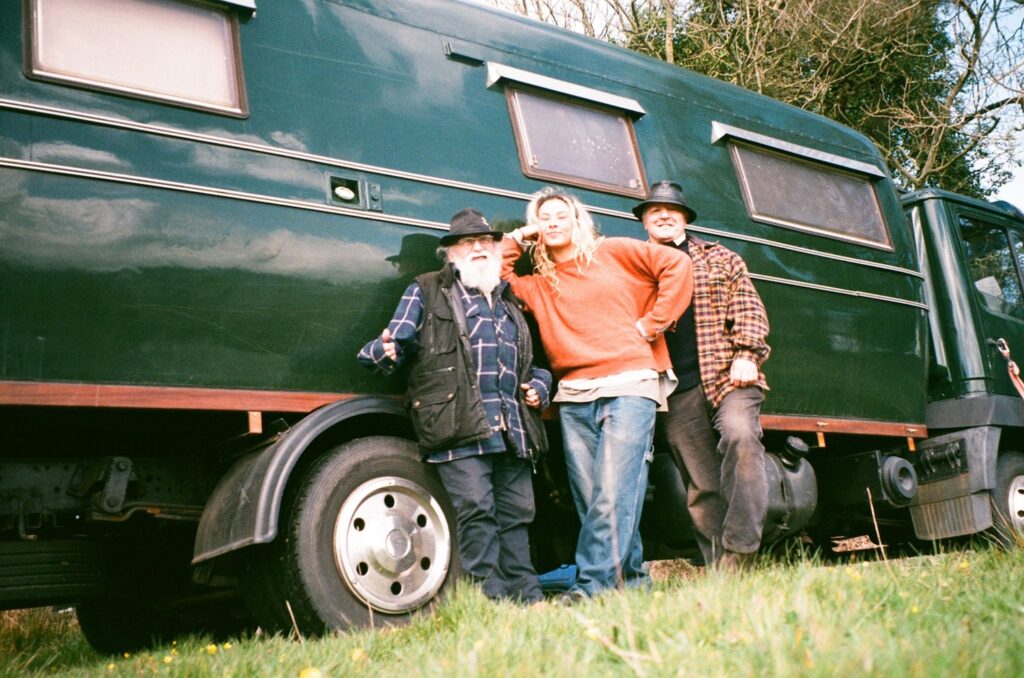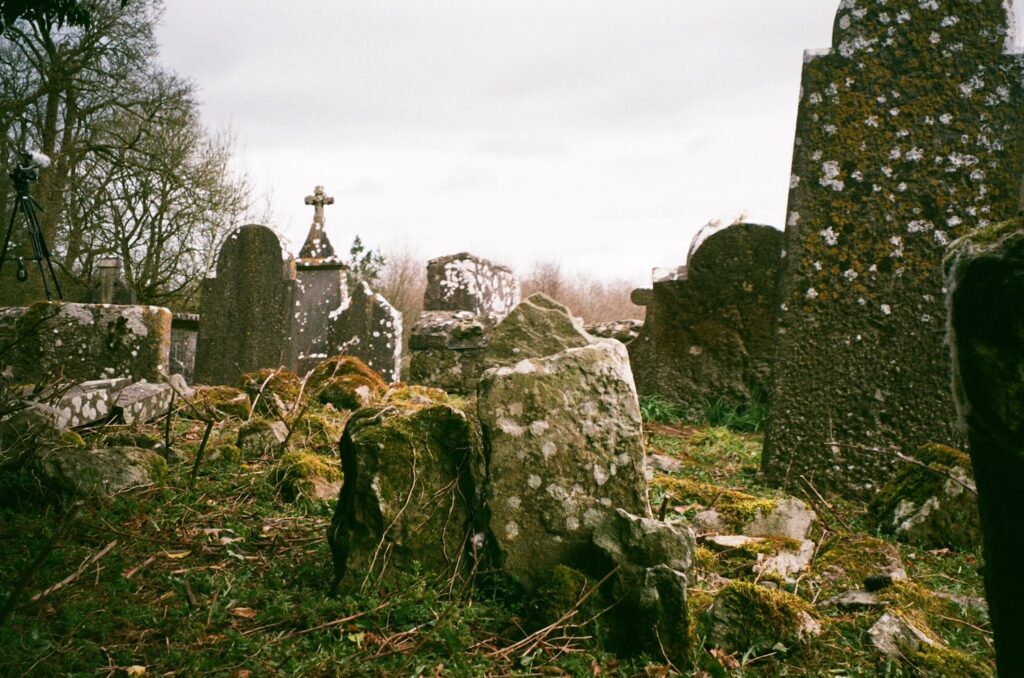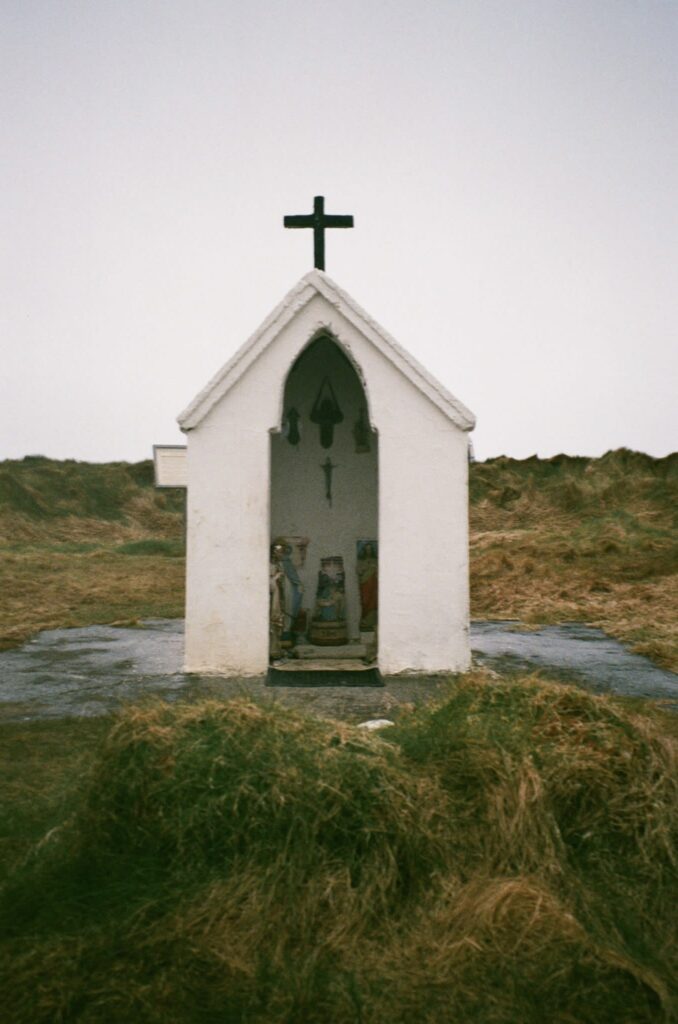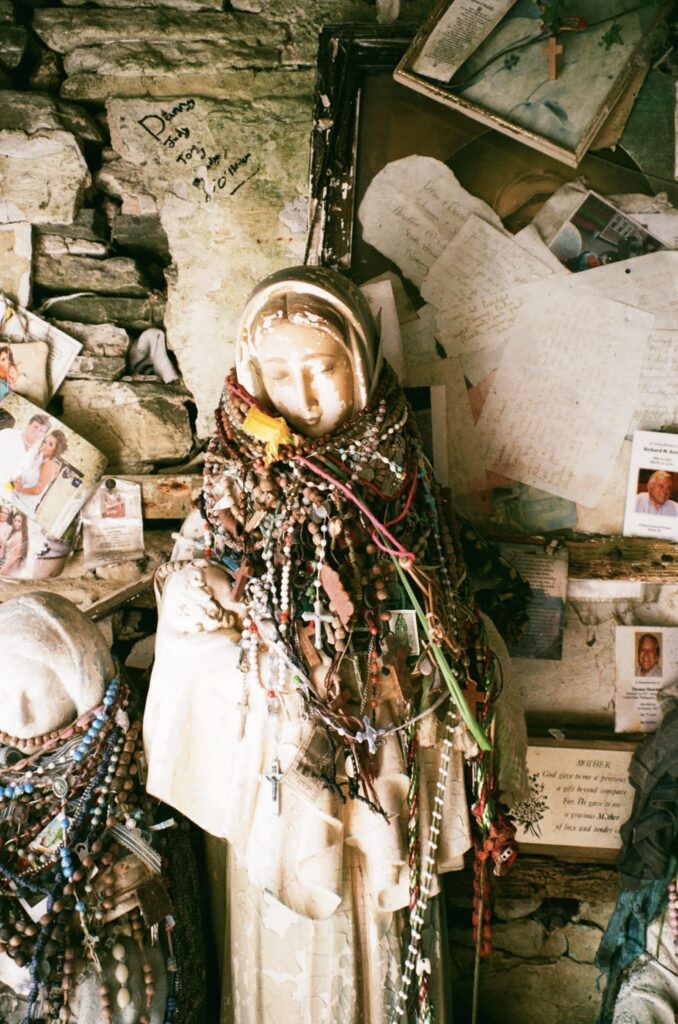Buried in the Shadows, Ireland’s Unconsecrated Dead
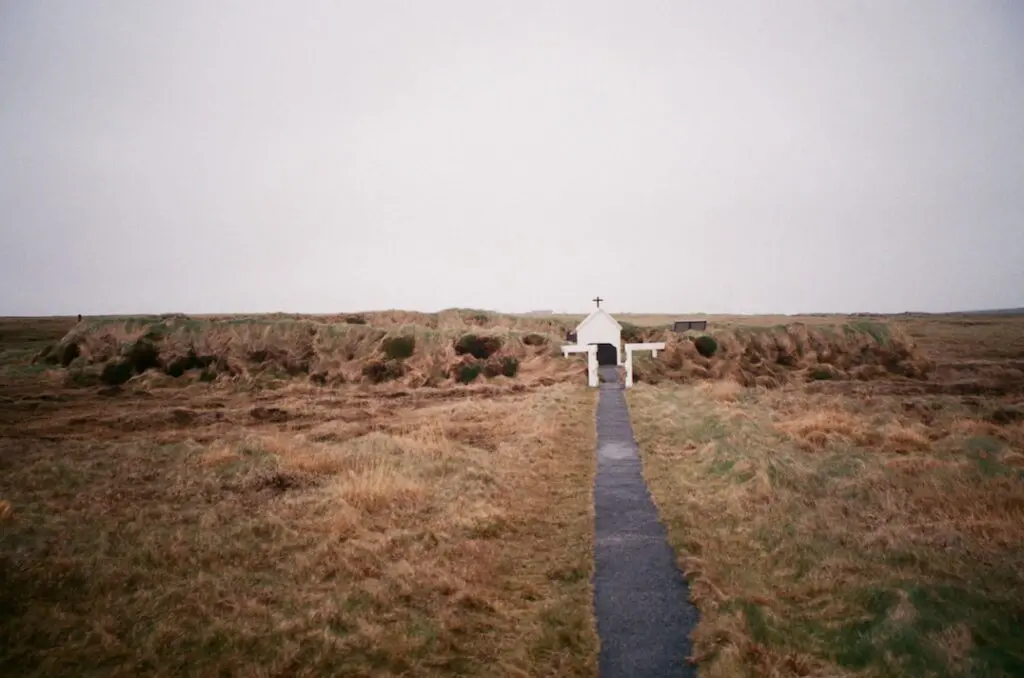
South of a graveyard, beyond a meadow, and to the right of a kissing gate, sits the holy well of Mooghna in County Clare. The day I visited, Tobermooghna was encased by thick white walls licked with a fresh coat of paint. Bill and Paddy, my companions on this trip, tumbled downward ahead of me, setting up their instruments at the foot of the well in preparation to sing a ghost song. Isolated underneath a halo of green, the air was still and quiet. I followed closely behind, noting a range of offerings lining the structure: a plastic saint, a beheaded Mary figurine with child, a porcelain boy with his back turned.
Who had placed these objects at this sacred place, and why?
I was in my final year of a master’s degree in visual anthropology, and I was traveling the western coast of Ireland to document sacred sites. As Bill and Paddy left me to return to their van, I felt a shift in the air.
As I approached the well with my camera, I felt like I was intruding. Unease crept through me as I adjusted my shot. Zooming in on the porcelain boy, my body stood stiff as if a disembodied gaze was fixed on me. Foreboding swelled as I held my breath. I packed my things and left.
Later that night, I couldn’t escape my lingering discomfort. My mind weighed heavily on stolen images. When I started researching Tobermooghna from the bowels of a half-vacant hotel, that’s when I found, quietly buried on the County Clare Heritage Office website, that Tobermooghna was located near a “small burying ground for children and strangers.”
In recent years, reckonings over unmarked graves have made headlines around the world. In Canada, the remains of more than 1,000 First Nations children were found near former residential schools. In the U.S., a recent task force discovered at least 53 mass burial sites at former federal Native American boarding schools. And in the European Union, over 1,000 unmarked graves of refugees and migrants who have died recently have been found along migration routes.
Read on from the SAPIENS archives: “Archaeology’s Role in Finding Missing Indigenous Children in Canada.”
In Ireland, a history of unmarked death takes its shape in the form of the cillín. Once seen as an essential part of Roman Catholic theology, cillíní were unmarked burial sites imposed by the church between the 17th and 20th centuries for those who were disqualified from burial on consecrated ground. These informal sites were usually located near pagan sites or old churchyards. The bereaved who were forced to bury their kin in these nameless places performed this funeral ritual between dusk and dawn, in a ceremony adjacent to the grace offered by consecrated land.
The bones of unbaptized babies, women who died in childbirth and out of wedlock, and those judged to be mentally ill or who were socially estranged were exiled to these places. Some burial sites could be considered as mass graves and were concealed from the public until a later date. In 2012, a local historian revealed one mass grave on the grounds of a former institution for unmarried mothers in Tuam, where 796 unmarked and unnamed children’s bodies were buried in a disused septic tank between 1925 and 1961. Unearthing these bodies and the histories surrounding them has started a wider conversation about the status of unmarked death in Ireland.
The unsettled feeling that overpowered me at Tobermooghna was linked to the bodies interred nearby. I had encountered a site where those who deviated from the social norms of the living sealed their fate as outsiders in death.
After my experience at Tobermooghna, I looked for people who had also stumbled across these histories and shared my sense of unease. That’s how I connected with Courtney Mundt, a U.S. academic based at Queens University, Belfast, who’s working to map cillíní in the Republic of Ireland. When she first learned about the burial sites, she realized how few of them had been documented. She embarked on a project speaking to locals, visiting counties, and finding these burial sites within the landscape.
Tobermooghna was a hidden and secluded site, a place lost to the folds of an Ordnance Survey. Yet, as I learned from Courtney and others, while these sites remain mostly hidden from public knowledge, many of these graves live actively in the minds of those who frequent them. They are not forgotten.
Cillíní were originally supported by the Catholic idea of Limbo, a spiritual purgatory that excludes membership to heaven but spares one from the throes of hell. For the parish and clergy, the souls buried at these sites were considered impure and thus perpetually suspended between these two worlds. They were denied a “good death” in the eyes of the church.
Starting in the 1960s, Catholic teaching around Limbo started to shift, with the church introducing a funerary rite for unbaptized children by 1969. In 2007, a Vatican-appointed panel of theologians dismissed the concept of Limbo, reflecting these changing ideas. However, resistance to Catholic dogma started long before this ideological shift, as seen in one of Ireland’s most well-known burial sites for unbaptized children, the Holy Angels plots at Glasnevin National Cemetery in Dublin.
An estimated 115,000 children are buried in three areas of the cemetery—many originally in common, unmarked graves. Some parents started memorializing the graves at least as early as the 1940s. Then, in the 1970s, coinciding with the Catholic Church’s relaxation of the education around Limbo, one of the plots became flooded with public mourning. In a few short years, it was consumed by stuffed animals and toys, a revolt in fur and plush that symbolized a history memorialized. Today the Holy Angels plots continue to be embraced with love and care through individualized burial markers and annual remembrance rituals.
Attempts to defy the Catholic desire to leave these deaths undocumented is not just a contemporary phenomenon. For centuries, in the face of intense marginalization, parents made deliberate material and geographical choices to commemorate their children’s lives. Cillíní were often located near pagan sites such as holy wells due to their enduring associations with healing powers and local saints. The wells are an integral part of Irish culture that have remained significant across pagan and Catholic traditions. They’re dotted across Ireland, with more remaining on the western coast, where British colonialism held less of a grip.
It’s easy to see how, for grieving parents, such sites offered an alternative, untethered system of meaning that existed outside of church walls. They created sacred spaces those in mourning couldn’t find elsewhere.
Many cillíní have been continuously and lovingly maintained over the years. Their locations have been held by oral histories, local knowledge, and in the memories of the bereaved. But others have been lost to time due to a history of stigma and when previously known cillíní were destroyed and converted to farmland. In Mundt’s research so far, she has accounted for more than 20 “new” discoveries of cillíní across the Republic of Ireland that had nearly been forgotten.
How we take care of the dead always reflects the values of the living.
On one trip to document these sites, Courtney confided to me that she had arrived at a cillín in Derrylin, located near St. Ninnidh’s Roman Catholic Church, when she became struck by grief. “As I started thinking about how these children and the adults that were buried in cillíní deserved better, I just burst into tears,” she told me. “The children and adults buried in the Derrylin cillín were on the other side of the graveyard wall, denied that little bit of peace that could have been brought to their souls, their families, and their friends if they’d been buried in consecrated ground. It hurt.”
Courtney’s work to “discover” cillíní is intended to formalize their recognition and, in turn, historically validate their existence. I felt myself doing the same with my camera, as if bringing some sort of permanence to the deaths might grant peace. The grief Courtney felt, and the care I noticed in the upkeep of the sites, only accounts for a fraction of what was experienced by those who were forced to bury their loved ones in this way—and the grief felt by a nation who lived under these exclusionary burial rites.
Looking back at my experience, I came to recognize that formal acknowledgment is not the sole or most important form of memorialization. The lack of official status for the gravesites is not indicative of the impact these deaths left.
Tobermooghna showed me that gestures of memorialization can be concealed in secrecy: etched in a stone, tied in a bow, and contained in a century’s worth of considered objects. Visitors still come to these sites of pilgrimage and prayer to heal, and in return, they provide a votive offering. Gifts of fading photographs and funeral cards, colored rags attached to trees, and pennies in the water. That’s where the magic of cillíní rests: not in their formal recognition but in the constant making and remaking of these places as people in the know express ongoing care for the dead.
How we take care of the dead always reflects the values of the living. The obscure nature of an unmarked grave suggests a life redacted from history, a life not entitled to remembrance. Yet history is not just that which is written; its stories exist in local minds, traveling tongues, and the identities of those who went through it.
A life that appears erased to wider society doesn’t ever depart unnoticed.
The author wishes to thank Bill Lloyd, Paddy, Saraí Humble, and the Fairy Council of Ireland for their support.
































